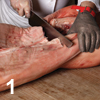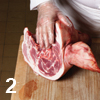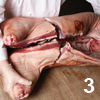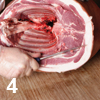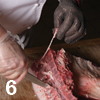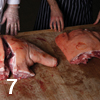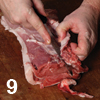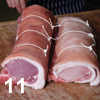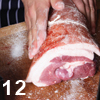Which pig?
What is pork? The answer depends on which sector of catering you are cooking in. At the popular end of the market, or the cost sector, or in any area where health concerns have a priority, it's seen as a lean meat, usually cooked through. On the other hand, chefs working at the aspirational end of commercial restaurants look to meat from rare-breed animals which they perceive as having a better image, owing to non-intensive rearing, better cooking and better eating qualities. The differences between the two kinds of pork can't be pinned down by a single experiment, but the following test carried out by José Souto and Pat Carey, senior lecturers at London's Westminster College, on a standard commercial carcass and one from a Gloucester Old Spot gives some indication of qualities caterers may expect to find when they opt for one or the other.
Gloucester Old Spot versus commercial pork
At a glance
Gloucester Old Spot pig
Cost price: £1.75 per kg without slaughter or delivery charges; total cost price inclusive of delivery from Gloucestershire wholesale butcher (Ensor) to Westminster College, £2.91
Carcass weight without pluck: 56kg
10-rib loin and best end, pre-trim: 5kg
Eye muscle diameter at the cut between loin and best end: about 6cm
Belly: 3kg
Hand and shoulder: 7kg
Leg: 8kg
Head: 6kg
Commercial Porker - Duroc X
(graded D3, an average fat-to-weight ratio)
Cost price: £1.91 per kg delivered from a London wholesale butcher [Fredericks]
Carcass weight without pluck: 72kg*
10-rib loin and best end, pre-trim: 5kg
Eye muscle diameter at the cut between loin and best end: about 7cm
Belly: 3.2kg
Hand and shoulder: 8.4kg
Leg: 9.3kg
Head: 5kg
\* This is right at the top end of standard pork weight.
Note: "Pluck" is the butcher's term for heart, liver, lungs and tongue.
Approximate composition of the loins and best ends for both carcasses (after trim):
Best end: 2.5kg bone-in, less spare ribs (200g), making 2.3kg
Loin: 2kg
Hard fat plus rind for crackling included in the above weights: 800g
Roasting notes summary:
- Convotherm oven (set for forced convection only) preheated to 210°C.
- Trimmed loins with rind attached both weighed 1.6kg raw.
- Gloucester Old Spot (raw core temperature 8°C): 15 minutes at 210°C plus 45 minutes at 130°C setting plus 10 minutes resting to a core temperature 68°C.
- Gloucester Old Spot weight before carving, with crackling removed: 1.165kg.
- Commercial Duroc x (raw core temperature 8°C): 15 minutes at 210°C plus about 70 minutes at 130°C setting plus 10 minutes resting to a core temperature 70°C.
- Commercial Duroc x weight before carving, with crackling removed: 0.946kg.
Prime pork joints: basic butchery
As a Westminster College third-year head of department, Pat Carey has special responsibilities for larder work. When he buys whole British graded pig carcasses of a good commercial standard, he checks that the tail is intact. Animals reared intensively under stressed conditions bite tails. Inside the carcass, he noted that there was no stickiness, which would have been the first sign of spoilage.
With the Gloucester Old Spot pig he found that its front teeth were fully developed - a sign that it was older than the commercial animal and had grazed on pasture. There was, however, a significant variation between the weights: Gloucester Old Spot, 56kg; barn-raised Duroc x, 72kg.
(Note: If buying a side of pork, rather than the whole beast, the steps below which involve sawing through backbone to split the joints won't be necessary.)
Step one: Work with a sharp, dedicated butcher's cleaver-type knife.
There are several ways of separating the legs from the rest of the carcass, depending on their intended use.
At Westminster College, Carey lays the animal on its back with the split carcass opposite him, and cuts through an imaginary line at
right-angles to the end of the leg (pic 1). He continues cutting through to the backbone on either side of the carcass, then saws through the backbone.
Lay the legs with the cut face towards you. Split them apart and divide them by sawing through the backbone.
Tips on sawing
- Listen for the sound of the saw going through the bone stopping, and then stop sawing.
- Always scrape away any bone-dust after sawing through any bone.
Step two: Remove the head. Mark out an imaginary line that runs along the neck from a point directly behind the ear. Cut through the neck on both sides. Use a saw to sever it from the rest of the carcass (pic 2).
The Gloucester Old Spot head weighs considerably more than a standard porker's.
In this test, the weights were 6kg and 5kg.
Step three: Separate the loin/best end from the shoulder/hand. Count 10 ribs along the rib cage. On either side of the carcass, cut between the 10th and 11th ribs (pic 3), then saw through the backbone. An accurate cut will just cut through the end of the shoulder blade (pic 4).
Split the loin by sawing through the centre of the backbone (pic 5). Scrape out the white spinal cord (pic 6).
Step four: Divide the hand of pork from the shoulder. Cut in a straight line through the hinge joining the shoulder blade to the fore-hock (pic 7).
Step five: Separate the belly from the loin/best-end. At the rib end of the loin, mark a spot along the ribs that is twice the diameter of the eye muscle. Cut and saw in a straight line from this point parallel to the backbone.
After the carcasses were cut, the primary joints were weighed and compared.
- The Gloucester Old Spot head is larger and heavier. Its cheeks, when boned out, weigh about 50g each.
- The flesh on the commercial animal is generally a darker pink. The loins/best ends were similar, despite the difference in carcass weight, but the eye muscle of the Gloucester Old Spot was smaller in the raw state.
Approximate gross weights of legs and shoulders as a percentage of the carcass:
- Gloucester Old Spot: legs, 28.5%; shoulders plus hand, 25%; loin, 17.5%; belly, 11%.
- Duroc x: legs, 26%; shoulders plus hand, 23%; loin, 14%; belly, 9%.
Weight loss owing to hanging, head, trimmings and kidneys accounts for the residual weights.
Preparing and roasting a loin or best end of pork
Preparing the joints In jointing the pig, the whole length of the back is often described as the "loin". When this prime cut is divided at the first rib, the joints created are then known as the loin and the best end.
Chining the loin or the best end 1. Chining. Saw through the ribs in a line close to and parallel to the backbone, taking care not to cut into the eye muscle. You may either chine the meat as a single piece or divide the loin from the best end and chine them separately (pic 8).
2. Keeping the knife blade tight to the backbone, separate it from the eye muscle, keeping the latter in reserve for roasting.
3. Keeping the knife blade tight to the ribs, between the eye muscle and the ribs, free the ribs (pic 9). (They can be used in spare ribs recipes: weight, around 200g.)
4. The rind is going to be used for its crackling.
It may be removed from the joint by slicing carefully through the layer of hard fat covering the eye muscle. After removing it, score it lightly with the tip of a knife. Note: on fatty animals, excessive fat may be pared away at this stage (weight including fat trim, 800g).
5. Roll and tie the joint. Lay a sheet of rind back over it and tie again, just firmly enough to hold it in place (pic 10).
Roasting
Two boned and rolled joints - one Gloucester Old Spot, one Duroc x, each weighing about 1.35kg without rind or the chine bone - were roasted in a forced convection oven. Before roasting, chefs noted that the commercially produced meat was longer and had a larger diameter eye muscle. Since both pieces weighed the same, we may conclude that the rare breed meat had a higher proportion of secondary (flank) muscle. Internal core temperature of raw meat should be 8°C (pic 11).
Preheat the oven to 210°C.
Rub the rind of each joint with salt (pic 12).
Lay the meat on the chines in separate, heavy-duty roasting tins.
Heat about 250ml sunflower oil to the smoking point, and pour it generously over the rind.
Put the meat directly into the oven and roast for 15 minutes. Open the oven door to check the meat, and then turn the oven setting down to 130°C. Test the core temperature at 45 minutes and again at 60 minutes.
At 65 minutes, the Gloucester Old Spot meat had reached a core temperature of 68° (recommended by the Meat and Livestock Commission for juicy meat with a hint of pink). It was rested for 15 minutes.
At 65 minutes, the other joint had reached about 54°C. After a further 25 minutes in the oven, it had reached 71°C, the temperature at which there were no pink juices. It was rested for 10 minutes.
General observations
- The crackling on the Duroc x was lighter, more bubbly and more even than on the Old Spot.
- The meat on the Gloucester Old Spot weighed 1.165kg, and on the Duroc x 0.946kg. It could not be established how much of this was due to the extra cooking time and higher core temperature of the latter, but the rare breed meat did appear to cook better.
- Trying to compare the taste of the two against each other is problematic, because the joints were no longer comparable. The Duroc x meat wasn't dry, but its texture was quite firm and dense; its flavour was relatively short on the palate. The Gloucester Old Spot was very succulent and tender, and left a lingering taste in the mouth. It did, though, have a pinkish streak between the eye muscle and the flank which would be considered desirable in certain styles of restaurant and unacceptable in others.
Jose Souto José Souto left Westminster College as a student in 1989 and went to work in Spain, before returning to England to work at the House of Commons.
In 2004 he was asked to do a lecture at what had, by then, become Westminster Kingsway College on game. He liked it so much he took a three-month sabbatical to see what lecturing was all about, and joined the college permanently in September 2004 as a chef-lecturer in culinary arts, specialising in game.
Pat Carey
Pat Carey moved to the UK from his native Ireland and has worked as a senior lecturer at Westminster Kingsway College for four years.
Prior to his move to England he was executive chef and national technical adviser to Van Den Bergh Foods (now Unilever Foodsolutions). He was also head chef at Roslyn Park in Dublin, where he trained chefs with disabilities.
The British Pig Association
The British Pig Association (BPA) (www.britishpigs.org) produces an interesting booklet on breeds that gives an insight into the way pork has evolved through time. The MLC's A Guide to Innovative and Versatile Pork Cuts has information on some of the newer seamed muscle joints that are available to caterers.
The BPA says: "Not all pork sold in this country is produced to British legal standards. Two-thirds of imported pork comes from farms that operate welfare practices that would be illegal in Britain. The British Pig Executive's Quality Standard Mark for pork, bacon and ham provides caterers with the reassurance that the products they are sourcing have been produced to high standards of welfare and quality assurance."
Further information is available from www.lookforthemark.co.uk.



